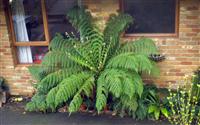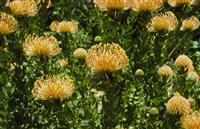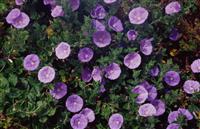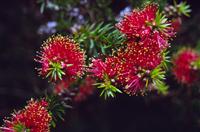 Plant Identification Skills are Essential for a Successful Career in Horticulture.
Plant Identification Skills are Essential for a Successful Career in Horticulture.
- Any good gardener, landscaper or horticulturist must be able to identify hundreds; if not thousands of plants
- There is a system that makes learning plant names easier
- This course sets you on the path to learning that system
- This course teaches you to identify and describe the culture of over 100 different plants which you have never learnt before.
 This course is a natural progression from Horticulture 1, but can be taken as a subject in its own. It concentrates on the identification, care and use of plants in a systematic way. Plant knowledge learnt here is in high demand in the horticulture industry. It is something prized by employers, but all too often minimized in modern courses due to financial constraints.
This course is a natural progression from Horticulture 1, but can be taken as a subject in its own. It concentrates on the identification, care and use of plants in a systematic way. Plant knowledge learnt here is in high demand in the horticulture industry. It is something prized by employers, but all too often minimized in modern courses due to financial constraints.
CONTENT
There are ten lessons in this course plus one Special Assignment (see later for details). The content of each of the ten lessons is outlined below:
1. The Groups of Plants ‑ This lesson sets a framework for the whole subject. Learn to identify plants from a wide range of taxonomic and cultural groups, using a range of different techniques.
 2. Use of Plants ‑ Learn about plant selection and soils; and review a bunch of other plant species.
2. Use of Plants ‑ Learn about plant selection and soils; and review a bunch of other plant species.
3. Australian Native Plants -Learn techniques for the growing of native shrubs and trees, including the selection, culture and use of different species.
4. Exotic Ornamental Plants -Learn techniques for the growing of exotic ornamental shrubs and trees, including the selection, culture and use of different species.
 5. Indoor & Tropical Plants -Learn techniques for the growing of indoor plants, including selection, culture and use of different varieties
5. Indoor & Tropical Plants -Learn techniques for the growing of indoor plants, including selection, culture and use of different varieties
6. Bedding Plants -Learn techniques for the growing of bedding plants, including selection, culture and use of different varieties.
7. Vegetables Learn techniques for the growing of edible crop plants, including selection, culture and use of vegetables.
8. Fruits, Nuts & Berries -Learn techniques for the growing of edible crop plants, including selection, culture and use of fruit, berries and nuts.
9. Herbs -Learn techniques for the growing, selection, culture and use of herbs.
10. Alternative Growing Techniques ‑ hydroponics, container growing, terrariums. Determine appropriate applications for a range of alternative growing methods
Aims
- Identify plants from a wide range of taxonomic and cultural groups, using a range of different techniques.
- Determine techniques for the growing of native shrubs and trees, including the selection, culture and use of different species.
 Determine techniques for the growing of exotic ornamental shrubs and trees, including the selection, culture and use of different species.
Determine techniques for the growing of exotic ornamental shrubs and trees, including the selection, culture and use of different species.
- Determine techniques for the growing of indoor plants, including selection, culture and use of different varieties.
- Determine techniques for the growing of bedding plants, including selection, culture and use of different varieties.
- Develop techniques for the growing of edible crop plants, including selection, culture and use of vegetables, fruit, berries and nuts.
- Determine appropriate applications for a range of alternative growing methods.
Duration: 100 hours
PLANT REVIEWS -are done in every lesson
 With each of the 10 assignments (not the special assignment) submitted, you should submit 12 plant specimens representing the following groups as outlined:
With each of the 10 assignments (not the special assignment) submitted, you should submit 12 plant specimens representing the following groups as outlined:
Natives 2 specimens per lesson
Exotic 2 specimens per lesson
Indoor plants 1 specimen per lesson
Flowers (annuals, bulbs or perennials) 2 specimens per lesson
Groundcover plants 1 specimen per lesson
Food plants or herbs 2 specimens per lesson
Plants of your choice 2 specimens per lesson
With each specimen you should include the following information:
1. Find your plants. You might find these plants growing in your own garden, or you might visit a nursery to find them.
2. Send in an illustration of the plant (see below) attached to a Plant Identification Worksheet (see next page).
3. Fill in details of the plant’s name, including the family it belongs to, its genus, species and, if you can, a common name.
4. Fill in remaining information about the plants in the spaces provided:
Propagation...state how to propagate it.
Height...how high it can grow in your locality?
Width...how wide can it grow in your locality?
Uses...what uses does the plant have with respect to amenity landscaping, crop production, etc.?
Hardiness...is it frost tender? Will it survive full sun or does it need shade? How does the wind affect it? Will it tolerate all types of soils? etc.
Culture...are there any special things the plant requires? How hard should it be pruned & how often? Does it need good drainage? How often should it be fertilised? etc.
Pest & Diseases...List any pests or diseases which are particularly significant for this plant.
Illustrating the Plant
This may be done any of the following ways:
a) Submit a photograph or drawing of parts of the plant.
b) Send a scan of a photograph or drawing. (Do not send large graphics files over the Internet. Consult your student manual for details.)
c) Refer to a web site page location where you have found the plant illustrated on the Internet. D) Submit a photograph of a pressed specimen. Note: Do not send pressed specimens across state or national boarders. To do so may be illegal and breach Quarantine law.
Feedback -A big part of Learning about Plants
All of these plant reviews are marked ande commented on by professional horticulturists (tutors), and their feedback is a big part of helping you learn.
This whole system of doing plant reviews, then reviewing the feedback you get, may be time consuming; BUT it is a tried and tested method. Whether you study by correspondence; or in a classroom -this is the way to learn plants. ....or at least the first couple of hundred.
Once you get into the swing of it; plant identification does eventually start to come much easier; and your knowledge and reputation as a true plantsman or plantswoman will start to really build.
Enrol Now.
 PLANT GROWING TIPS FROM OUR STAFF....
PLANT GROWING TIPS FROM OUR STAFF....
GROWING PLANTS IN COASTAL GARDENS
You are on holidays at the beach house, or you live in a coastal town, and you’re having problems growing plants in the garden. Maybe your plants are yellowing, burnt or stunted, or possibly you can’t even get them established in the first place. If this sounds familiar, we’ll give you some ideas on how to overcome common problems in growing plants by the coast.
Firstly, you may need to change your expectations. It is not possible to grow the same range of plants that flourish a few kilometres inland – many plants simply can’t tolerate the salt levels, dry sandy soil and wind exposure of the coast. If your ideal garden is a lush green lawn surrounded by roses and azaleas, forget it – you will always be struggling against the natural conditions and it is unlikely that you’ll ever achieve a really healthy and attractive garden. It is better to choose plants adapted to seaside growing and modify the site to encourage these to grow to the best of their ability.
Depending on how close you are to the sea, and how exposed your garden is, there are several problems which you will need to deal with; the most severe being high salt levels both in the soil, and carried in wind and water sprays, and physical damage from strong winds.
Dealing with Salt
Salt is carried by wind and is deposited on the plants and onto the soil. It can cause severe leaf burn and defoliation; over time the plants become stunted and fail to thrive, especially those growing on the seaward side. The problem is compounded as salt accumulates in the soil.
Choosing salt-hardy plants and blocking the passage of salt-laden wind are the best strategies. The plant lists below will help you to select appropriate plant species.
Creating Wind Breaks
Coastal winds damage plants in several ways:
- causing physical damage to limbs, especially in storms
- causing stunting (shortened limbs and small leaves), as a result of long-term exposure
- carrying salt deposits that accumulate on foliage
- carrying sand that abrades leaf tissues, resulting in leaf drop and shoot dieback (often called wind pruning)
- carrying salt deposits that accumulate in the soil
A barrier that prevents or slows down the prevailing wind, therefore, is paramount in a coastal garden. A good windbreak greatly enhances the variety of plants that can be grown in the garden.
Solid fences and walls are useful because they can be erected quickly. These include brick walls and timber or brush fences. A drawback is that they can create turbulence as the wind is forced up and over the fence. A permeable fence (ie. a fence that wind can move through) is a better choice as it will filter the wind and reduce its speed. Shade cloth, lattice, hessian (as a temporary measure) are good choices.
Growing hardy salt tolerant plants as front line protection against wind is the best long-term windbreak. A mixture of shrubs and trees that filter the wind is better than using a solid line of one species. Plants also have the advantage that they bind the soil, reducing soil erosion. Some of the hardiest plants to use are those that are indigenous to the area (they are native to the area and are accustomed to the local conditions).
 Other Strategies for Growing Coastal Plants
Other Strategies for Growing Coastal Plants
- Tree guards
Plastic tree guards or shade cloth supported by stakes will help protect newly planted trees and shrubs.
- Growing in containers
Salt sensitive plants can be grown in pots. Use a good quality potting mix and preferably place the pot in a sheltered spot, away from salt laden winds.
- Conserving moisture
Even if your garden receives regular amounts of rain, the plants can still suffer from water shortage. Sandy soils are very free draining, so adding organic materials and using surface mulches is important. Seaweed is the most obvious choice for a mulching material – it’s free and is usually plentiful, but it needs to have any surface salt washed off before you use it. Many soils consisting of high levels of fine sand commonly are water repelling, particularly when they have been allowed to dry out. Water from irrigation or rain will sit on the surface in puddles, or run away down slope without much infiltrating into the soil. They are said to be hydrophobic. This problem can be overcome by the addition of wetting agents such as Saturaid or Wettasoil.
- Installation of a drip irrigation system will also help plants establish and grow.
- Fertilisers
Coastal soils are generally impoverished and have limited capacity to retain applied nutrients. Organic materials are useful; also apply slow release fertilisers (eg. blood and bone or Osmocote) to promote growth.
 Hardy Seaside Plants
Hardy Seaside Plants
Trees
Acacia longifolia var. sophorae (Coast Wattle)
Agonis flexuosa (Willow Myrtle)
Allocasuarina littoralis, A. torulosa, A. verticillata (Drooping She Oak)
Araucaria bidwilli (Bunya Bunya Pine), A. cunninghamii (Hoop Pine), A. heterophylla (Norfolk Island Pine)
Arbutus unedo (Irish Strawberry Tree)
Banksia integrifolia (Coastal Banksia), B. serrata
Callistemon viminalis (Weeping Bottlebrush)
Callitris columellaris (Coast Cypress Pine)
Casuarina cunninghamiana, C. equisetifolia subsp. Incana
Cocos nucifera (Coconut Palm)
Cupressus macrocarpa (Monterey Cypress)
Eucalyptus ficifolia (Red Flowering Gum), E. botryoides, E. calophylla ‘Rosea’ (Pink-flowered Marri), E. lehmannii (Bushy Yates)
Melaleuca armillaris, M. elliptica, M. nesophila, M. squarrosa
Metrosideros excelsa (NZ Christmas Tree)
Olea europea (Olive)
Phoenix canariensis (Date Palm)
Pinus nigra maritima (Corsican Pine)
Tamarix parvifolia (Tamarisk)
Tristania laurina
Shrubs
Acacia saligna
Agave attenuata
Banksia ericifolia (Heath Banksia)
Banksia marginata
Brachysema lanceolata (Swan River Pea)
Callistemon citrinus, C. rigidus
Coprosma repens (Mirror Plant)
Cordyline australis
Correa alba, C. reflexa
Dodonea viscosa (Hop Bush)
Echium candicans (Pride of Madeira)
Escallonia macrantha
Feijoa (Pineapple guava)
Hakea laurina (Pincushion Hakea), H. sauveolens
Hebe cultivars
Kunzea ambigua
Leptospermum laevigatum (Coast Tea Tree)
Leptospermum petersonii (Lemon-scented Tea Tree)
Leucophyta brownii (Cusion Bush)
Melaleuca fulgens, M. hypericifolia, M. laterita
Murraya exotica (Mock Orange)
Myoporum insulare (Boobialla)
Nerium oleander (Oleander)
Olearia sp. (Daisy Bush)
Polygala sp.
Raphiolepis species and cultivars (Indian Hawthorn)
Rosmarinus officinalis (Rosemary)
Vitex spp.
Westringia fruticosa (Coastal Rosemary)
Groundcovers/Small Shrubs
Alyssum maritimum (Sweet Alice)
Arctotis (Aurora Daisy)
Carprobrotus glaucescens (Pig Face)
Cerastium tomentosum (Snow in Summer)
Hemerocallis (Day Lily)
Hibiscus scandens (Snake Vine)
Gazania (Gazania)
Mesembryanthemum sp. (Pigface)
Myoporum acuminatum (Boobialla)
Osteospermum cultivars (African Daisy)
Pelargonium australe
Sedum spp.
Scaevola aemula
Stachys byzantina (Lamb’s Ears)
Climbers
Bougainvillea
Ficus pumila (Climbing Fig)
Hedera helix (Ivy)
Hibbertia scandens (Guinea Gold Vine)
Petrea volubilis (Purple wreath)
Pyrostegia venusta (Orange Trumpet Vine)
Solandra guttata (Cup of Gold)
Tecomanthe hillii
By John Mason and Staff
ACS Distance Education
WHO CAN BENEFIT FROM THIS COURSE?
This course is suited to:
- Anyone working in the horticulture industry who wishes to improve their plant knowledge
- People who are hoping to get work in the horticulture or conservation industries
- Gardening and plant enthusiasts